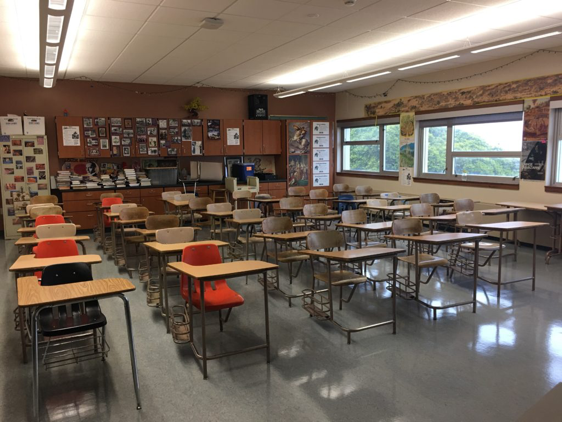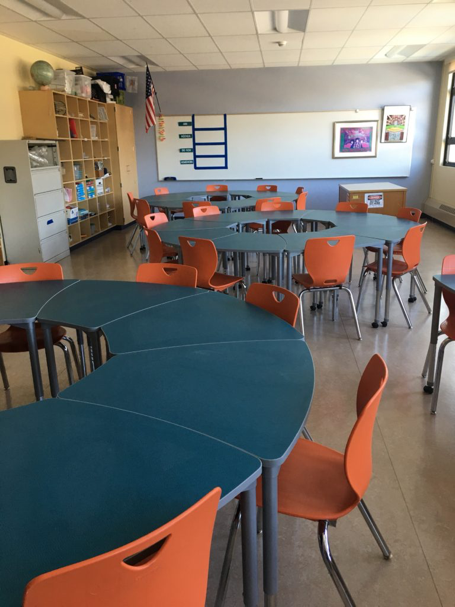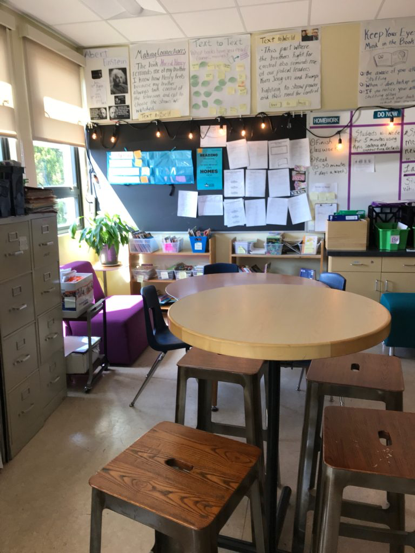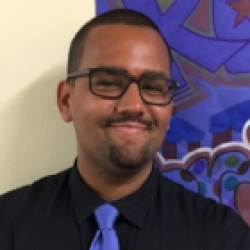
Superintendents are pressured to improve test scores and reform schools, which usually sparks discussion of teaching practice and hyper-testing. These changes are often met with extreme resistance, shallow compliance, and overly simplified new strategies.
This doesn’t work.
What if I told you that there was a way to change instructional practice without talking much about instruction? What if I told you there was a way to get folks to discover the change needed for themselves? (Cue the Inception bass soundtrack.) It all could start with getting rid of those insidious individual desks.
Round them up. Build a pile. Add gasoline, a match, and watch them burn.
Or build a huge pile, and call it a monument to the days when learning was teacher-centered and millions of students were left behind (pun intended). Similar to confederate monuments that we leave up to remind us of an oppressive time that we don’t want to return to, let’s walk past the “tower of torture” every day to deter us from ever going back.
Early Reflections on Classroom Furniture
I have always hated single seat desks in classrooms, because I see them as tools of oppression, and quite appropriate for subjugating the masses. In college, I remember taking a course called Education and Democracy at UC Berkeley, with Professor Hurst. We would all sit in a big circle and discuss educational issues. He let us pick our own topics to research and ultimately select our final grade. This was crazy even for liberal Cal, but I learned tons and was inspired to be a teacher.
Later, as a Spanish teacher, I switched out those desks for tables conducive to group work. They allowed for students to work together, communicate, and they had a more of a communal feel.
And then I became a school leader, of Visitacion Valley Middle School. I walked around the new school, discovering room after room, filled with individual desks.
How the hell would I change an entire school?

Flash forward. It took me three years, but I finally got rid of every last one of those godforsaken individual desks. If you didn't know, school furniture is nowhere near affordable, especially if you want something that will last. In addition, some teachers are damn near joined at the hip to these desks in the classroom, similar to students sitting like slaves shackled to them. In my head, I have PTSD flashbacks of a teacher saying “I didn’t give you permission to get up.”
How did we do it?
- Visit schools to see redesigned spaces.
- Start with your bright spots.
- Apply to grants, big and small.
- Work with district partners like the iLAB at SFUSD
- Use your school budget.
- Start hacking towards change.
- Highlight your believers to build momentum.
- Look for donations and local office liquidations.

What can the redesigned classroom look like?
School Retool, a design thinking fellowship, put on at Stanford University's Design School, calls it the "defronted classroom." I learned about this during their four-month workshop series. There is NO front. There are many fronts. It is no longer teacher as the sage on the stage. No more sitting in rows, listening to a robot read from a 1950s textbook, or click through slides from 1998 Microsoft PowerPoint. It is 2018, right? The chairs and tables can have wheels (for moving). There might be ottomans and yoga balls.
On top of that, there could be a rug, even though they aren't in kindergarten anymore. There might even be a (cue Phantom of the Opera organ) sofa in the room. There can be smart boards or TV screens or whiteboard paint on the walls. There can be a computer station or a cart of laptops. The tables are grouped for collaboration but can be moved into other configurations. Maybe there's not even a teacher desk! There is no "look at me" podium. Oh yeah, and there ain't no more individual desks. And the students are moving, talking, taking control, and LEARNING.
Imagine that.

What Else Happened?
- We blew up the master schedule and bell schedule
- We used funding to leverage more funding
- We began to rethink how we used staff meetings
- Staff started attending conferences like the New Tech Network Annual Conference
What’s happening now?
- We doubled our enrollment in the 6th grade and improved our reputation
- We are piloting culturally responsive Project-Based Learning school-wide
- Teachers are setting up structures for student academic conversations
- Teachers are requesting rugs and ottomans to set up reading nooks
- We are discussing deeper learning, the use of technology, and personalized learning
- We are introducing group roles schoolwide along with descriptions, rubrics, and visuals
What's Next?
I want to redesign ALL the rooms. We now have group tables in every room or new flexible seating, but I want everything to look immaculate and innovative. If we want our students to believe they have access to work at any tech startup or non-profit, they should get used to it. Also, now it's about exploring different models. Teaching is both science and art, so let Einstein and Basquiat get busy in the classroom. The trick will be knowing which one to use.
Conclusions
I used to be focused on changing teacher practice. I was relentless, but I had it all wrong. It’s often been said that form follows function, meaning that if a teacher wants to teach in a novel way, then they will change their environment. This is only true for those who are trailblazers, innovators, and risk takers. Anthony Muhammad calls these folks the believers, and they are only a part of the plan.
But many educators from an older generation and were assimilated to think inside the box. For this large group, we need to change the form first, and then the function will follow. I actually had a teacher say, after completing a design thinking process, “I see now that if my classroom changes, I need to teach differently.” This is why we need to change the environment.
It’s funny that now I am always trying to get teachers moving their chairs into a circle and promote dialogue. Thanks, Professor Hurst and the many inspiring writers, speakers, and mentors I encountered along the way.

